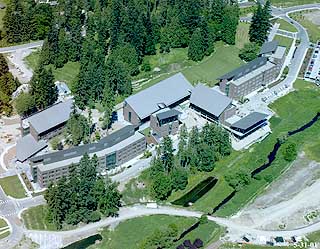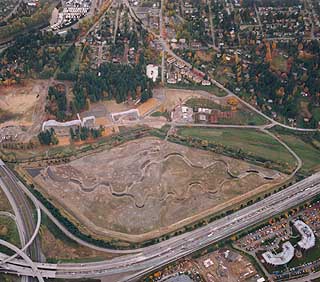
Surveys
DJC.COM
July 12, 2001
UW Bothell — a wetland lesson in the making
Mortenson

Photo courtesy of Soundview Aerial Photography UW Bothell-Cascadia is flanked by trees in addition to its 58 acres of wetlands. |
In July 1998, Mortenson began construction of a new joint university campus and community college campus located in Bothell. The project, administered by the state Department of General Administration, is the collocated home of the suburban University of Washington-Bothell branch campus and the new Cascadia Community College campus.

Mannon |
Of the 127 acres allotted for new construction, 58 acres were designated for wetland creation and enhancement, which includes rerouting a creek to its original floodplain. This is one of the largest wetland restorations ever undertaken in the Pacific Northwest.
Mortenson began the restoration on July 2, 1998, under the direction of Dr. Lyndon Lee, a wetland scientist from L.C. Lee and Associates. Even though project architect NBBJ minimized impacts on North Creek by locating the campus on upland areas of the site, development still required filling about six acres of wetlands. To mitigate the environmental impact of construction, the project has restored the structure and function of the North Creek riverine ecosystem on the site.
Over 100 years ago, this migratory salmon stream was straightened to serve as a log flume to transport harvested timber to Lake Washington. We will relocate over a quarter of a mile of this stream to its original meandering path through a primary and secondary channel resulting in restoration of 58 acres of floodplain ecosystem.
The new North Creek main channel was designed with bed and bank features, meanders, and a variety of in-channel habitats, including pools, riffles, and engineered log jams.
Microdepressions and floodplain berm structures were created to mimic the topography of wind-thrown trees. In the summer of 2001, the existing stream channel will be slowly deflected to the new channel, including the transplanting of migratory fish.
Restoration involved importing over 1,000 logs to be used for channel stabilization and as nurse logs for certain species of native plants. The planting plan for the wetlands requires over 500,000 plants chosen from about 20 native plant community types typically found within the Puget Sound lowlands. Many of these plants have been propagated in a temporary greenhouse located on the site. Wetlands work is spread over a four-year period to allow new plantings to become established.
In conjunction with the wetland restoration, Mortenson is maintaining environmentally conscious practices at the construction site. Carelessness during construction could potentially impact the overall success of the restoration by affecting the health of plants, stream microorganisms, and fish.

Photo courtesy of Soundview Aerial Photography The campus’ 58-acre wetland with the new North Creek diversion under construction. |
Throughout the project, daily turbidity tests confirm that North Creek is not being affected by the ongoing construction. Three sediment control ponds have been installed to help filter the suspended solids from the water before they enter the creek.
“Mortenson has been an instrumental part in the success of such a large-scale project and minimizing the sediment erosion control,” said Lee “Peter Hrynyshyn, Mortenson’s superintendent, has been very responsive to environmental actions and proactive in maintaining the site. The magnitude of the site, soil conditions, and public exposure has been one of the challenges Mortenson has been able to control.”
In addition to turbidity , the water was tested for pH daily. PH values are created from high concentrations of concrete in the water. With the locations of two buildings within 50 feet of the wetlands, this potentially could have been a larger problem for us. To prevent high pH and run off from the adjacent buildings, we constructed sediment ponds, diverted areas of run off and prevented concrete trucks from cleanout near the North Creek.
Concrete can cause tremendous spikes in pH, and all concrete activities were monitored and runoff controlled. Due to the wet climate in Washington, if not protected and preventative methods were put into place the endangered fish could be impacted.
As of July 23, 2001, the stream diversion will begin. This work includes the creation of additional log jams for transitioning water to the new channel and fish removal. Diverting the flow of water will require three weeks of “fish sweeps.”
A manual means of removing the fish will be performed by R2 Resource Consultants. Once the fish have been moved and the stream is actively flowing, the existing North Creek will be backfilled. This backfill is available from the existing stockpile on the site and will not be complete until the end of September.
We look forward to seeing our first salmon spawning through the channel in the early part of the fall. Not only will this give us great pride in constructing a new streambed, but also will give us the satisfaction of knowing that we have done a small part in trying to help preserve an endangered Northwest species for years to come.
At the completion of both the stream diversion and backfill, more planting and irrigation will be added to the site. This work will take place in early October. A regional trail and boardwalk will be constructed at the wetlands buffer. Mortenson is also currently involved in the historic preservation/rehabilitation of the Chase House, one of the oldest houses in Bothell, which when opened in the fall will serve as an interpretive center for the wetlands and will serve as an hands-on educational tool for the greater Puget Sound.
In memory of Duane Mannon, senior project manager for Mortenson, who was involved since the beginning of preconstruction on the UW/Cascadia Community College collocated campus. It was with his efforts along with many others that helped to make this project a success.
Other Stories:
- Pesticide-free parks teach new lessons
- Construction faces new foe: toxic mold
- Water metering: the debate trickles on
- Studies sniff out Tacoma smelter plume
- Tree investment brings cities many happy returns
- From wood preservation to site remediation — the Cascade Pole cleanup
- New rules for birds, bogs and bulldozers
- Isolated wetlands ruling creates confusion
- Environmental metamorphosis on the Duwamish
- Mitigation banks balance habitat, development
- New Pin Foundation minimizes site impacts
- Bringing a city stream back to life
- Knitting a trail of green
- Stormwater problems? Put a LID on it
- More brownfield incentives in the pipeline
- Helping environmental groups to get wired
- Shedding light into the permit ‘black hole’
- Frequently asked ESA questions
- Muddy waters: The new 4(d) salmon rule
- Global climate change starts at home
- At EPA, next 4 years won’t be boring
- Dams vs. fish? Mediate it!
- 'House calls' help firms to conserve
- Building a greener future on Bainbridge
- Power users, producers turn toward the sun
- Seattle goes climate neutral
- Bamboo’s popularity shoots up
- Tiny town recycles Goliath proportions
- MTCA revisions take effect Aug. 15
- Environmental education: Knowing what’s in your backyard
- Bear Creek roars again
- SEPA document trends since GMA and regulatory reform
Copyright ©2009 Seattle Daily Journal and DJC.COM.
Comments? Questions? Contact us.